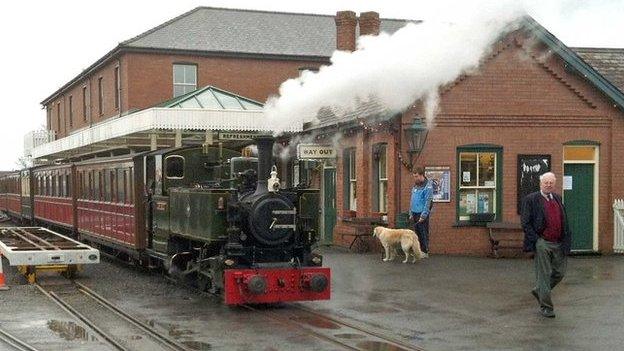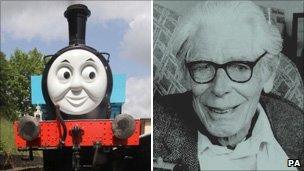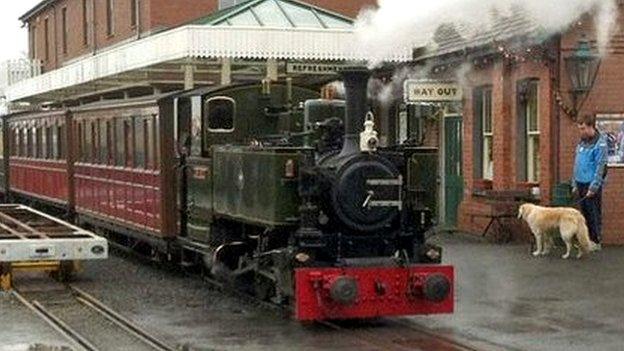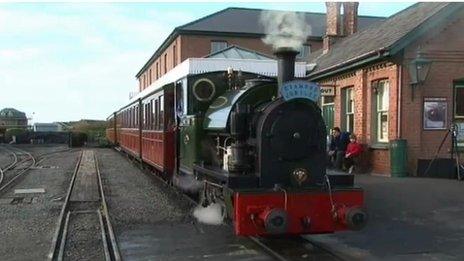Talyllyn Railway celebrates 150th birthday
- Published

Talyllyn Railway turns 150 this weekend
It was the world's first passenger-carrying narrow gauge railway, provided the inspiration for Thomas the Tank Engine and, this weekend, the Talyllyn Railway celebrates its 150th birthday.
Built to serve the slate quarry of Bryn Eglwys, near Abergynolwyn, Gwynedd, in 1950 it seemed doomed when owner Henry Haydn Jones died and the quarry closed.
But a group of West Midlands tourists vowed to safeguard it.
And so, Talyllyn became the UK's first preservation railway.
More than 60 years on, it continues to hold a place in Midlanders' hearts, including its current general manager, proud Brummie, Chris Price.
"In 1950, nothing like this had ever been done," he said.
"The railways had just been nationalised - although Talyllyn was left out - and the world was all about moving on and modernising after the war.

Thomas the Tank Engine and his creator, Wilbert Awdry
"People thought they were crackers, wanting to save this dilapidated old railway, but Talyllyn held so many special memories and had achieved so many railway firsts that they were determined they were going to make it work.
"Today we have 350 dedicated volunteers, and we're running the original 1860s engines on 7m (12km) of track, with some absolutely fantastic new stations and, of course, the narrow gauge museum."
The Talyllyn Railway has always done things the hard way.
After construction had already begun on its bridges, a Board of Trade inspector spotted they were too narrow for the 2ft 3in (0.68m) gauge.
This meant the carriages would not have the required clearance on either side.
Planks as seats
To alleviate this problem, the doors on one side of each carriage were permanently barred and the track slewed off-centre beneath the bridges to allow passengers enough room to get out if the train stopped underneath.
While the alterations were taking place the inspector withheld a safety certificate, meaning the first passengers were warned they were travelling at their own risk.
Nevertheless, tourists flocked to the Talyllyn Railway in such numbers that, in order to keep up with demand, slate wagons had to be fitted with planks as seats.

Thomas the Tank Engine has been popular with children
But the boom failed to last and by 1947 services ran on only two days a week, with stations and rolling stock alike in a state of gradual decay.
Tom Rolt, founding chairman of the Talyllyn Railway Preservation Society, once said the herculean task of breathing new life into the line had required "a boy's own comic spirit of adventure, enthusiasm, ingenuity and a fair degree of irresponsibility".
Mr Price believes most - but not all - of these qualities can still be found in abundance in today's group of volunteers.
"Today the railway is run incredibly professionally, without the daredevil risks, but that same enthusiasm is still everywhere you look," he said.
"People only have to come here once and they're bitten. And not just people who can remember the age of steam, we also have a flourishing young members' group."
Beautiful
"The smells, the sounds, the beautiful scenery, you never get tired of it. I can confidently say the Talyllyn Railway will be here in another 150 years' time."
One of those who was similarly inspired by the railway was the Reverend W Awdry.
It was after a visit to Talyllyn in the early days of preservation that he was moved to write his Railway Series of Thomas the Tank Engine stories.
He based his Skarloey Railway on Talyllyn and drew on many real-life experiences of the preservations for his tales.
Today, the Talyllyn Railway carries around 100,000 passengers a year, and its success has spawned hundreds of preservation railways throughout the UK.
Related topics
- Published22 May 2014

- Published24 September 2014

- Published3 January 2013

- Published30 October 2011
